Rice Husk Ash Incorporation in Calcium Aluminate Cement Concrete: Life Cycle Assessment, Hydration and Strength Development
Abstract
:1. Introduction
2. Materials and Methods
2.1. Materials and Mixture Proportions
2.2. Manufacturing and Testing Specimens
Mechanical and Microstructural Tests
2.3. LCA Methodology
2.3.1. Environmental Impact Assessment
- (a)
- Goal and scope definition
- (b)
- Inventory analysis
- (c)
- Environmental impact assessment and interpretation phase
2.3.2. Goal and Scope
2.3.3. Inventory Analysis
3. Results
3.1. Hydration Process of 90-Day Paste
3.2. Hardened CACC Features
3.2.1. Compressive Strength
3.2.2. Tensile Strength
4. LCA Findings
4.1. Impact Assessment
4.2. Midpoint Assessment
4.3. Endpoint Assessment
5. Conclusions
- Based on the TGA results, the concretes with RHA experienced a greater mass drop than those without RHA at temperatures from 200 to 300. This can be attributed to the fact that incorporating 5% RHA in CACC increases the hydration level and in turn improves the mechanical features compared with the concrete without RHA at an age of 90 days.
- All the mechanical features of the 90-day specimens were higher than those of the 7- and 28-day specimens. Furthermore, at 90 days, the specimens with RHA had higher mechanical features than the control specimens, and the specimen with 5% RHA had the maximum improvement. The reason for this is a higher hydration level in concrete containing RHA, which led to a larger loss of mass in the 200–300 °C range in the TGA test, as a result of the C-S-H gel degradation.
- The recipe midpoint and endpoint methods were used to assess the environmental impacts and the results showed the positive environmental impacts of using RHA in concrete. In this regard, adding 5 and 10% RHA in concrete decreased CO2 emissions by 18.75% and 38%, fine particulate matter release by 34% and 68%, and ozone depletion level by 31% and 60%, respectively. Critical environmental aspects including CO2 emissions, fine particulate matter release, ozone depletion, and land use notably decreased by replacing cement with RHA.
Author Contributions
Funding
Conflicts of Interest
References
- Jefferis, S.A.; Mangabhai, R.J. Effect of temperature rise on properties of high alumina cement grout. In Calcium Aluminate Cements; Chapman and Hall: London, UK, 1990; p. 363. [Google Scholar]
- Scrivener, K.L.; Cabiron, J.-L.; Letourneux, R. High-performance concretes from calcium aluminate cements. Cem. Concr. Res. 1999, 29, 1215–1223. [Google Scholar] [CrossRef]
- Bensted, J. Calcium aluminate cements. Struct. Perform. Cem. 2002, 2, 114–138. [Google Scholar]
- Parr, C.; Wöhrmeyer, C.; Veyrat, D. High purity calcium aluminate binders for demanding high temperature applications. In Proceedings of the centenary conference “Calcium Aluminate Cements”, Avignon, France, 30 June–2 July 2008; pp. 417–428. [Google Scholar]
- Williams, C.M.; Garrott, F. Recycling/Reclaiming a savings spree: Chicago reuses to the max on famous shopping mile. Ill. Interchang. Ill. Dep. Transp. Springf. 2012. Available online: https://www.roadsbridges.com/recyclingreclaiming-savings-spree (accessed on 5 January 2022).
- Abolhasani, A.; Nazarpour, H.; Dehestani, M. The fracture behavior and microstructure of calcium aluminate cement concrete with various water-cement ratios. Theor. Appl. Fract. Mech. 2020, 109, 102690. [Google Scholar] [CrossRef]
- Scrivener, K.L.; Taylor, H.F.W. Microstructural development in pastes of a calcium aluminate cement. In Calcium Aluminate Cements; Mangabhai, R.J., Ed.; 1990; Available online: https://www.researchgate.net/publication/40754958_Microstructural_development_of_calcium_aluminate_cement_based_systems_with_and_without_supplementary_cementitious_materials (accessed on 5 January 2022).
- Abolhasani, A.; Samali, B.; Aslani, F. Physicochemical, Mineralogical, and Mechanical Properties of Calcium Aluminate Cement Concrete Exposed to Elevated Temperatures. Materials 2021, 14, 3855. [Google Scholar] [CrossRef] [PubMed]
- Khaliq, W.; Khan, H.A. High temperature material properties of calcium aluminate cement concrete. Constr. Build. Mater. 2015, 94, 475–487. [Google Scholar] [CrossRef]
- Antonovič, V.; Kerienė, J.; Boris, R.; Aleknevičius, M. The Effect of Temperature on the Formation of the Hydrated Calcium Aluminate Cement Structure. Procedia Eng. 2013, 57, 99–106. [Google Scholar] [CrossRef] [Green Version]
- Newman, J.; Choo, B.S. Advanced Concrete Technology Set; Elsevier: Amsterdam, The Netherlands, 2003. [Google Scholar]
- Bronzeoak Ltd. Rice Husk Ash Market Study. Available online: www.berr.gov.uk/files/file15138.pdf (accessed on 5 January 2022).
- Rizwan, S.A. High-Performance Mortars and Concretes Using Secondary Raw Materials. Ph.D. Thesis, Technischen Universistat Bergakademie, Freiberg, Germany, 2006. [Google Scholar]
- Kamiya, K.; Oka, A.; Nasu, H.; Hashimoto, T. Comparative Study of Structure of Silica Gels from Different Sources. J. Sol-Gel Sci. Technol. 2000, 19, 495–499. [Google Scholar] [CrossRef]
- Mehta, P.K. Rice husk ash—A unique supplementary cementing material. In Proceeding International Symposium on Advances in Concrete Technology; Malhotra, V.M., Ed.; Symposium Paper: Athens, Greece, 1992; pp. 407–430. [Google Scholar]
- Della, V.P.; Kühn, I.; Hotza, D. Rice husk ash as an alternate source for active silica production. Mater. Lett. 2002, 57, 818–821. [Google Scholar] [CrossRef]
- Henry, C.S.; Lynam, J.G. Embodied energy of rice husk ash for sustainable cement production. Case Stud. Chem. Environ. Eng. 2020, 2, 100004. [Google Scholar] [CrossRef]
- Mehta, P.K. Role of pozzolanic and cementitious material in sustainable development of the concrete industry. Int. Concr. Abstr. Portal 1998, 178, 1–20. [Google Scholar]
- Ganesan, K.; Rajagopal, K.; Thangavel, K. Rice husk ash blended cement: Assessment of optimal level of replacement for strength and permeability properties of concrete. Constr. Build. Mater. 2008, 22, 1675–1683. [Google Scholar] [CrossRef]
- El-Dakroury, A.; Gasser, M.S. Rice husk ash (RHA) as cement admixture for immobilization of liquid radioactive waste at different temperatures. J. Nucl. Mater. 2008, 381, 271–277. [Google Scholar] [CrossRef]
- Feng, Q.; Yamamichi, H.; Shoya, M.; Sugita, S. Study on the pozzolanic properties of rice husk ash by hydrochloric acid pre-treatment. Cem. Concr. Res. 2004, 34, 521–526. [Google Scholar] [CrossRef]
- Burritt, R.L.; Herzig, C.; Tadeo, B.D. Environmental management accounting for cleaner production: The case of a Philippine rice mill. J. Clean. Prod. 2009, 17, 431–439. [Google Scholar] [CrossRef]
- Alnahhal, M.F.; Alengaram, U.J.; Jumaat, M.Z.; Alqedra, M.A.; Mo, K.H.; Sumesh, M. Evaluation of Industrial By-Products as Sustainable Pozzolanic Materials in Recycled Aggregate Concrete. Sustainability 2017, 9, 767. [Google Scholar] [CrossRef] [Green Version]
- Limbachiya, M.; Meddah, M.S.; Ouchagour, Y. Use of recycled concrete aggregate in fly-ash concrete. Constr. Build. Mater. 2012, 14, 13–18. [Google Scholar] [CrossRef]
- Abolhasani, A.; Aslani, F.; Samali, B.; Ghaffar, S.H.; Fallahnejad, H.; Banihashemi, S. Silicate impurities incorporation in calcium aluminate cement concrete: Mechanical and microstructural assessment. Adv. Appl. Ceram. 2021, 120, 104–116. [Google Scholar] [CrossRef]
- Abolhasani, A.; Shakouri, M.; Dehestani, M.; Samali, B.; Banihashemi, S. A comprehensive evaluation of fracture toughness, fracture energy, flexural strength and microstructure of calcium aluminate cement concrete exposed to high temperatures. Eng. Fract. Mech. 2022, 261, 108221. [Google Scholar] [CrossRef]
- Abolhasani, A.; Nazarpour, H.; Dehestani, M. Effects of silicate impurities on fracture behavior and microstructure of calcium aluminate cement concrete. Eng. Fract. Mech. 2020, 242, 107446. [Google Scholar] [CrossRef]
- Abolhasani, A.; Samali, B.; Dehestani, M.; Libre, N.A. Effect of rice husk ash on mechanical properties, fracture energy, brittleness and aging of calcium aluminate cement concrete. Structures 2021, 36, 140–152. [Google Scholar] [CrossRef]
- Kurda, R.; Silvestre, J.D.; de Brito, J. Life cycle assessment of concrete made with high volume of recycled concrete aggregates and fly ash. Resour. Conserv. Recycl. 2018, 139, 407–417. [Google Scholar] [CrossRef]
- Jiang, M.; Chen, X.; Rajabipour, F.; Hendrickson, C.T. Comparative Life Cycle Assessment of Conventional, Glass Powder, and Alkali-Activated Slag Concrete and Mortar. J. Infrastruct. Syst. 2014, 20, 04014020. [Google Scholar] [CrossRef]
- Robayo-Salazar, R.; Mejía-Arcila, J.; de Gutiérrez, R.M.; Martínez, E. Life cycle assessment (LCA) of an alkali-activated binary concrete based on natural volcanic pozzolan: A comparative analysis to OPC concrete. Constr. Build. Mater. 2018, 176, 103–111. [Google Scholar] [CrossRef]
- Vayghan, A.G.; Khaloo, A.R.; Nasiri, S.; Rajabipour, F. Studies on the Effect of Retention Time of Rice Husk Combustion on the Ash’s Chemo-Physical Properties and Performance in Cement Mixtures. J. Mater. Civ. Eng. 2012, 24, 691–697. [Google Scholar] [CrossRef]
- Chao-Lung, H.; Tuan, B.L.A.; Chun-Tsun, C. Effect of rice husk ash on the strength and durability characteristics of concrete. Constr. Build. Mater. 2011, 25, 3768–3772. [Google Scholar] [CrossRef]
- Madandoust, R.; Ranjbar, M.M.; Moghadam, H.A.; Mousavi, S.Y. Mechanical properties and durability assessment of rice husk ash concrete. Biosyst. Eng. 2011, 110, 144–152. [Google Scholar] [CrossRef]
- American Standard Testing and Material. Standard Specification for Concrete Aggregates. 2003. Available online: https://www.studocu.com/row/document/rajanagarindra-rajabhat-university/marketing-communication/c-33-03-standard-speci%EF%AC%81cation-for-concrete-aggregates/8672282 (accessed on 5 January 2022).
- BS EN 12390-3. Testing Hardened Concrete. Method of Determination of Compressive Strength of Concrete Cubes. 2000. Available online: http://www.engr.hk/T06/BS%20EN%2012390-3(2002).pdf (accessed on 5 January 2022).
- ASTM. Standard Test Method for Splitting Tensile Strength of Cylindrical Concrete Specimens. C496/C496M-11. 2011. Available online: https://pdfcoffee.com/standard-test-method-for-splitting-tensile-strength-of-cylindrical-concrete-specimens-1-pdf-free.html (accessed on 5 January 2022).
- Zobel, T.; Almroth, C.; Bresky, J.; Burman, J.-O. Identification and assessment of environmental aspects in an EMS context: An approach to a new reproducible method based on LCA methodology. J. Clean. Prod. 2002, 10, 381–396. [Google Scholar] [CrossRef]
- ISO. Environmental Management: Life Cycle Assessment. In Principles and Framework; ISO: Geneva, Switzerland, 2006; Volume 14044. [Google Scholar]
- Schneider, L.; Berger, M.; Finkbeiner, M. The anthropogenic stock extended abiotic depletion potential (AADP) as a new parameterisation to model the depletion of abiotic resources. Int. J. Life Cycle Assess. 2011, 16, 929–936. [Google Scholar] [CrossRef]
- Junnila, S.; Horvath, A.; Guggemos, A.A. Life-Cycle Assessment of Office Buildings in Europe and the United States. J. Infrastruct. Syst. 2006, 12, 10–17. [Google Scholar] [CrossRef]
- Khasreen, M.M.; Banfill, P.F.G.; Menzies, G.F. Life-Cycle Assessment and the Environmental Impact of Buildings: A Review. Sustainability 2009, 1, 674–701. [Google Scholar] [CrossRef]
- ISO. Internationale de Normalisation, Sustainability in Building Construction: Environmental Declaration of Building Products; ISO: Geneva, Switzerland, 2007. [Google Scholar]
- AzariJafari, H.; Amiri, M.J.T.; Ashrafian, A.; Rasekh, H.; Barforooshi, M.J.; Berenjian, J. Ternary blended cement: An eco-friendly alternative to improve resistivity of high-performance self-consolidating concrete against elevated temperature. J. Clean. Prod. 2019, 223, 575–586. [Google Scholar] [CrossRef]
- Chungsangunsit, T. Environmental Assessment of Electricity Production from Rice Husk: A Case Study in Thailand, Electricity Supply Industry in Transition: Issues and Prospect for Asia. EU-ASEAN COGEN 3 Program. 2004. Available online: https://books.google.com/books?id=eHENDgAAQBAJ&pg=PA184&lpg=PA184&dq=Environmental+Assessment+of+Electricity+Production+from+Rice+Husk:+A+Case+Study+in+Thailand,+Electricity+Supply+Industry+in+Transition:+Issues+and+Prospect+for+Asia&source=bl&ots=naLV5av-ud&sig=ACfU3U0R3EeUbkr1BPq7slm01Tk0khqEZQ&hl=id&sa=X&ved=2ahUKEwiWie3vj7j1AhVKZt4KHUo1AooQ6AF6BAgCEAM#v=onepage&q=Environmental%20Assessment%20of%20Electricity%20Production%20from%20Rice%20Husk%3A%20A%20Case%20Study%20in%20Thailand%2C%20Electricity%20Supply%20Industry%20in%20Transition%3A%20Issues%20and%20Prospect%20for%20Asia&f=false (accessed on 5 January 2022).
- Wang, Q.; Maezono, T.; Apaer, P.; Chen, Q.; Gui, L.; Itoh, K.; Kurokawa, H.; Sekiguchi, K.; Sugiyama, K.; Niida, H.; et al. Characterization of suspended particulate matter emitted from waste rice husk as biomass fuel under different combustion conditions. WIT Trans. Ecol. Environ. 2012, 157, 365–376. [Google Scholar] [CrossRef] [Green Version]
- Mehta, P.K.; Monteiro, P.J.M. Microstructure and properties of hardened concrete. Concr. Microstruct. Prop. Mater. 2006, 41–80. [Google Scholar]
- Padhi, R.S.; Patra, R.K.; Mukharjee, B.B.; Dey, T. Influence of incorporation of rice husk ash and coarse recycled concrete aggregates on properties of concrete. Constr. Build. Mater. 2018, 173, 289–297. [Google Scholar] [CrossRef]
- Chindaprasirt, P.; Homwuttiwong, S.; Jaturapitakkul, C. Strength and water permeability of concrete containing palm oil fuel ash and rice husk–bark ash. Constr. Build. Mater. 2007, 21, 1492–1499. [Google Scholar] [CrossRef]
- Le, H.T.; Nguyen, S.T.; Ludwig, H.-M. A Study on High Performance Fine-Grained Concrete Containing Rice Husk Ash. Int. J. Concr. Struct. Mater. 2014, 8, 301–307. [Google Scholar] [CrossRef] [Green Version]
- Thomas, B.S.; Gupta, R.C.; Kalla, P.; Cseteneyi, L. Strength, abrasion and permeation characteristics of cement concrete containing discarded rubber fine aggregates. Constr. Build. Mater. 2014, 59, 204–212. [Google Scholar] [CrossRef]
- Noaman, M.A.; Islam, M.N.; Islam, M.R.; Karim, M.R. Mechanical properties of brick aggregate concrete containing rice husk ash as a partial replacement of cement. J. Mater. Civ. Eng. 2018, 30, 4018086. [Google Scholar] [CrossRef]
- Salas, A.; Delvasto, S.; DE Gutierrez, R.M.; Lange, D. Comparison of two processes for treating rice husk ash for use in high performance concrete. Cem. Concr. Res. 2009, 39, 773–778. [Google Scholar] [CrossRef]
- Van Tuan, N.; Ye, G.; van Breugel, K.; Fraaij, A.L.; Bui, D.D. The study of using rice husk ash to produce ultra high performance concrete. Constr. Build. Mater. 2011, 25, 2030–2035. [Google Scholar] [CrossRef]
- Fapohunda, A.C.; Akinbile, B.; Shittu, A. Structure and properties of mortar and concrete with rice husk ash as partial replacement of ordinary Portland cement—A review. Int. J. Sustain. Built Environ. 2017, 6, 675–692. [Google Scholar] [CrossRef]
- Nazari, A.; Riahi, S. RETRACTED: Splitting tensile strength of concrete using ground granulated blast furnace slag and SiO2 nanoparticles as binder. Energy Build. 2011, 43, 864–872. [Google Scholar] [CrossRef]
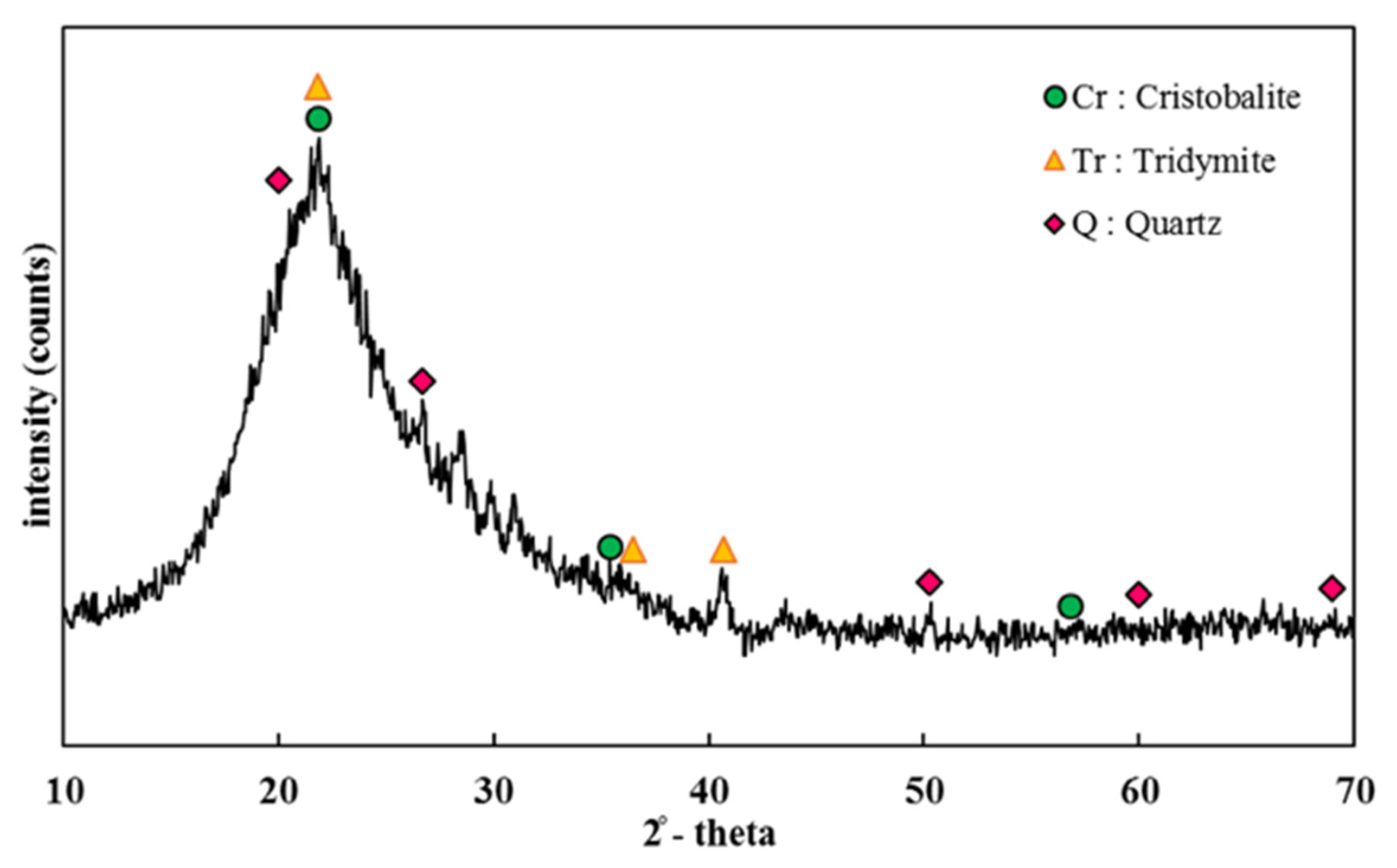
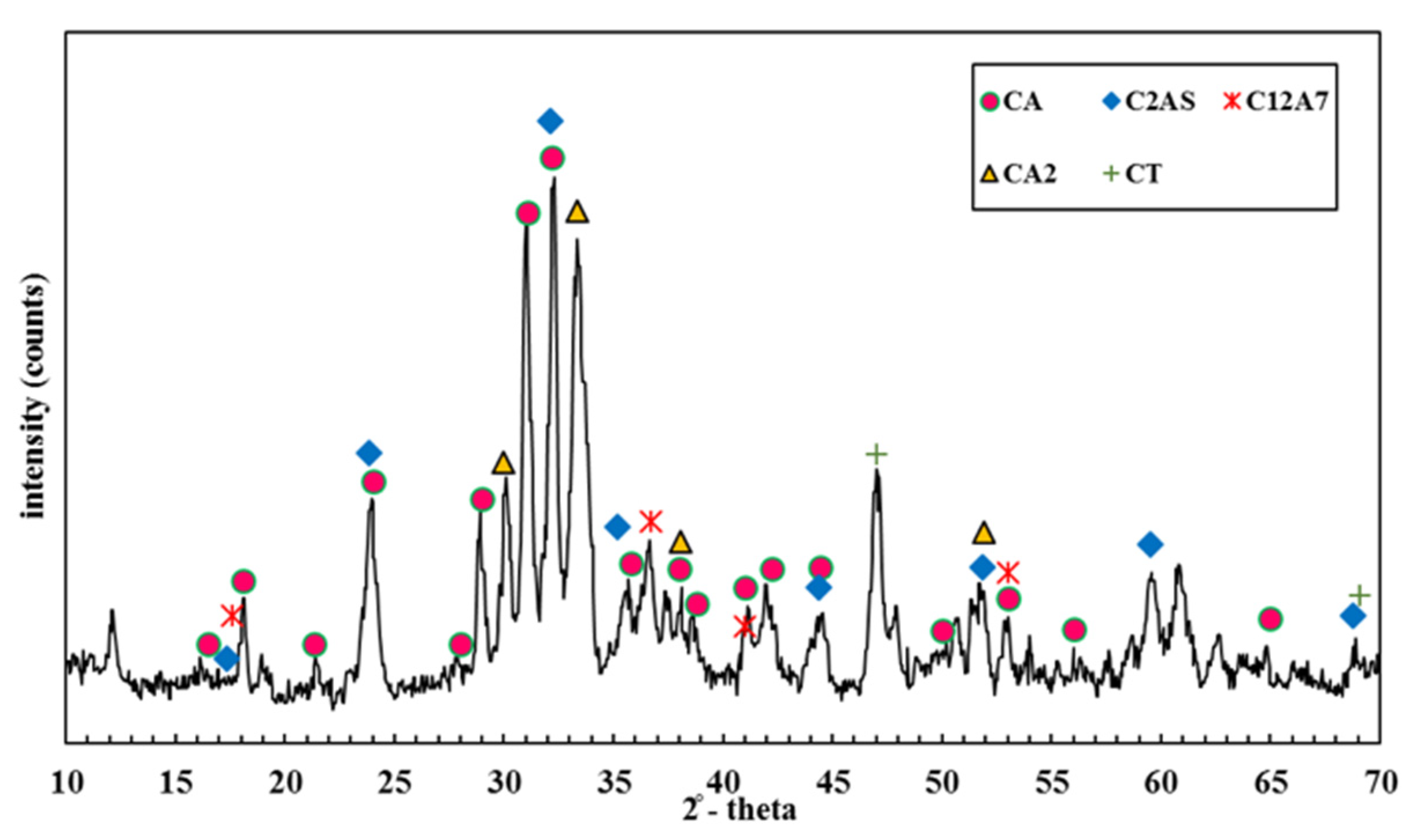
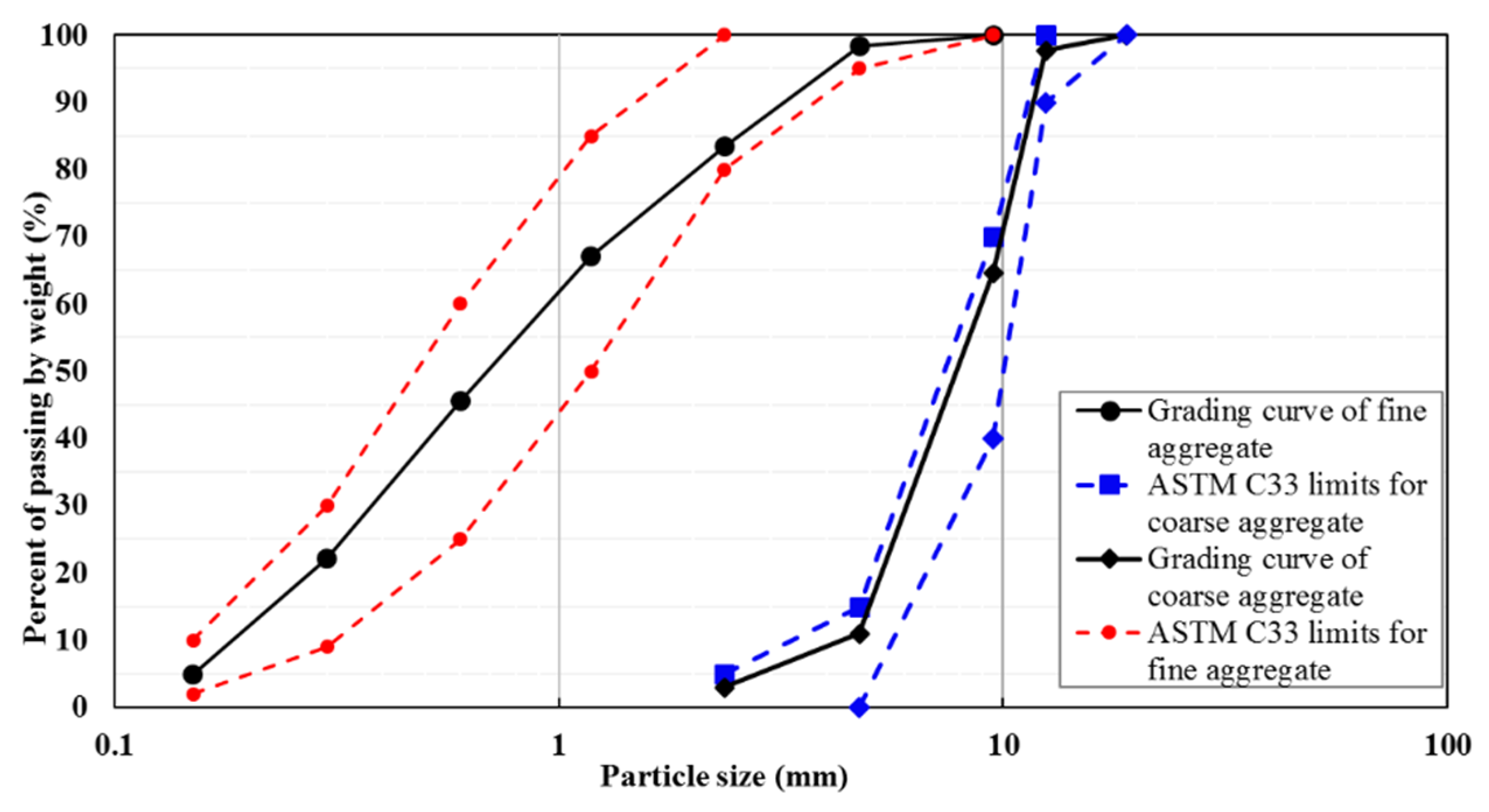

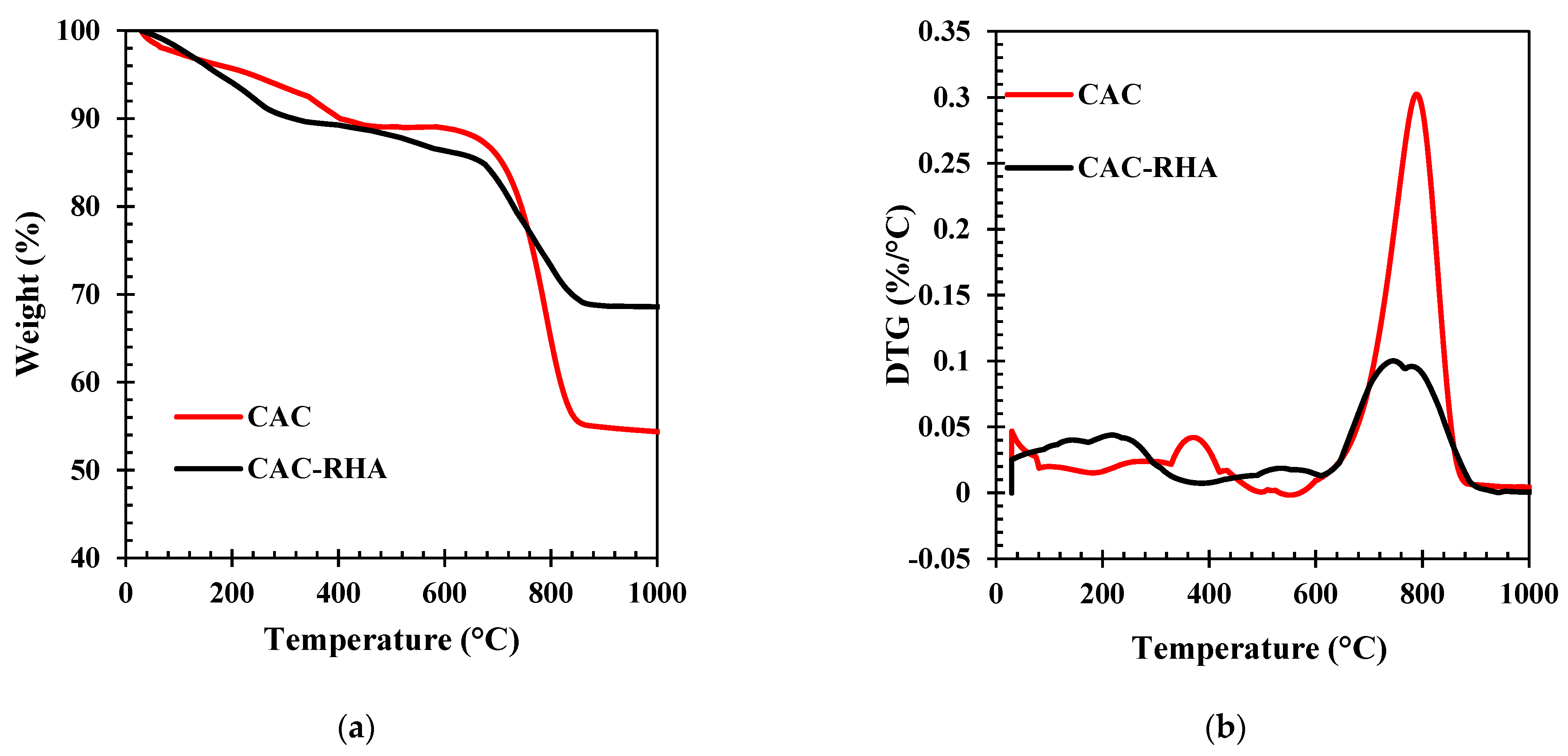
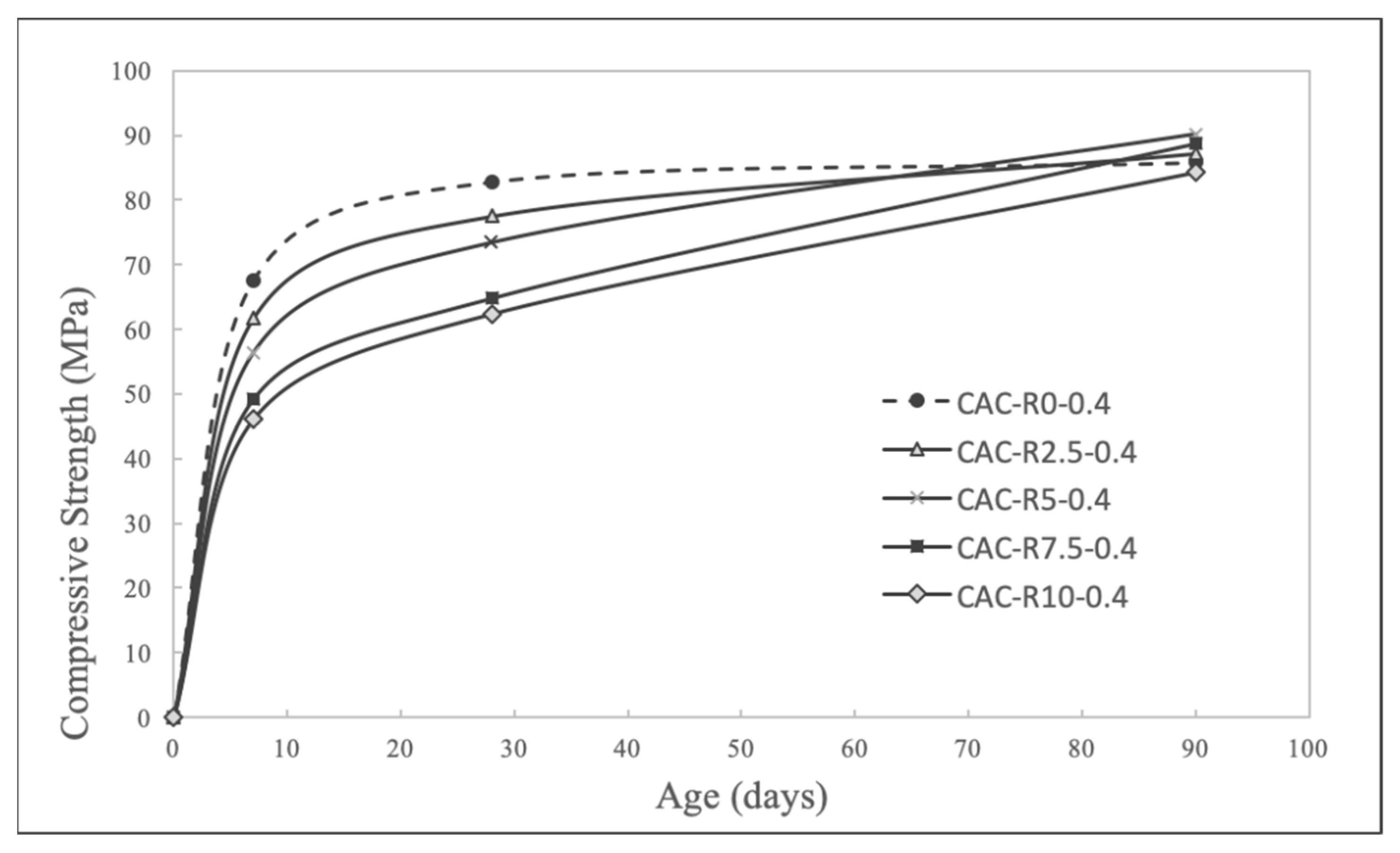
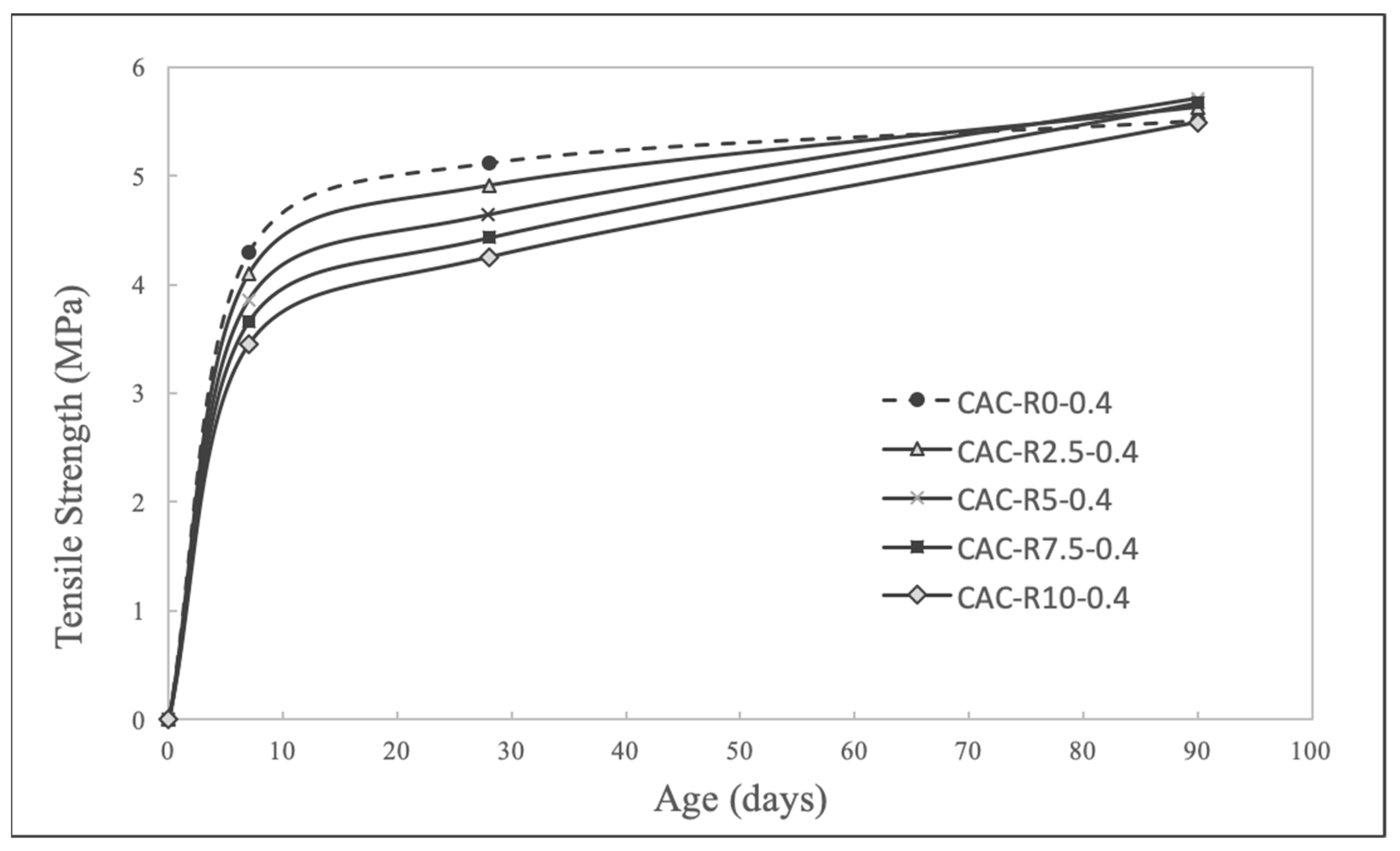
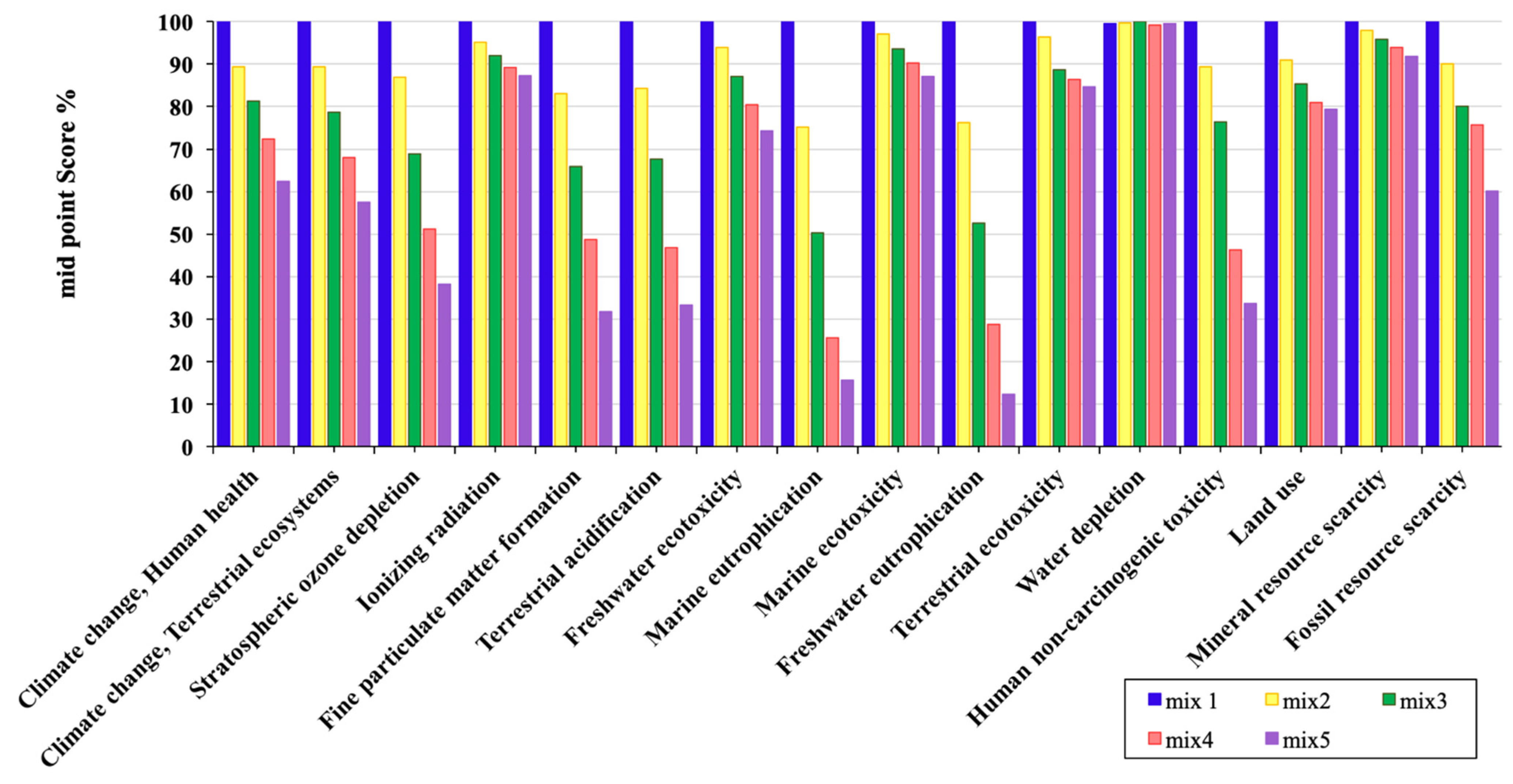

| Oxide Composition (%) | Ig. Loss | Blaine Surface Area | Specific Gravity | |||||||||
|---|---|---|---|---|---|---|---|---|---|---|---|---|
| RHA | 90.11 | 1.19 | 0.848 | 0.897 | 0.89 | 0.861 | - | 3.84 | 0.099 | 4.05 | 3600 | 2.32 |
| CAC | 5.25 | 38.22 | 13.87 | 0.97 | 37.49 | 0.089 | 0.311 | 0.072 | 0.078 | 1.04 | 2900 | 2.98 |
| Mix Number | Mix Name | Coarse Aggregate | Fine Aggregate | , (SP/Binder) | Slump (mm) | |||
|---|---|---|---|---|---|---|---|---|
| Mix1 | CAC-RHA0-0.4 | - | 450 | 180 | 840 | 905 | 0.378 (0.08%) | 100 |
| Mix2 | CAC-RHA2.5-0.4 | 11.25 | 438.75 | 180 | 840 | 905 | 0.756 (0.16%) | 95 |
| Mix3 | CAC-RHA5-0.4 | 22.5 | 427.5 | 180 | 840 | 905 | 1.512 (0.33%) | 80 |
| Mix4 | CAC-RHA7.5-0.4 | 33.75 | 416.25 | 180 | 840 | 905 | 2.646 (0.58%) | 60 |
| Mix5 | CAC-RHA10-0.4 | 45 | 405 | 180 | 840 | 905 | 2.989 (0.66%) | 60 |
| Input/output | Unit | Value |
|---|---|---|
| Cement | kg | Based on mix designs |
| Sand | kg | 840 |
| Crushed Gravel | kg | 905 |
| Water | kg | 180 |
| Superplasticizer | kg | Based on mix designs |
| Materials and Energy used for processing of Rice husk ash | ||
| Electricity | MJ | 6.30 × 101 |
| Rice husk | kg | 2.43 × 102 |
| Carbon dioxide | kg | 3.36 × 102 |
| Carbon monoxide | kg | 5.90 × 100 |
| Nitrogen dioxide | kg | 6.39 × 10−1 |
| Methane | kg | 1.94 × 100 |
| Dust (PM 2.5) | kg | 1.94 × 100 |
| Rice Husk Ash | kg | 4.92 × 101 |
| RHA transportation | kJ/kg | 3.8 (distance 32 km) |
| Mix Design | Average Compressive Strength-7 Days (COV) | Average Compressive Strength-28 Days (COV) | Average Compressive Strength-90 Days (COV) |
|---|---|---|---|
| CAC-R0-0.4 | 67.6 MPa (±2.31%) | 82.5 MPa (±2.86%) | 85.8 MPa (±2.49%) |
| CAC-R2.5-0.4 | 61.73 MPa (±3.96%) | 77.47 MPa (±4.05%) | 87.24 MPa (±3.8%) |
| CAC-R5-0.4 | 56.4 MPa (±2.05%) | 73.38 MPa (±2.33%) | 90.13 MPa (±2.88%) |
| CAC-R7.5-0.4 | 49.21 MPa (±2.38%) | 64.82 MPa (±1.45%) | 88.65 MPa (±5.41%) |
| CAC-R10-0.4 | 46.1 MPa (±2.67%) | 62.43 MPa (±1.49%) | 84.32 MPa (±3.15%) |
| Mix Design | Average Tensile Strength-7 Days (COV) | Average Tensile Strength-28 Days (COV) | Average Tensile Strength-90 Days (COV) |
|---|---|---|---|
| CAC-R0-0.4 | 4.3 MPa (±2.86%) | 5.12 MPa (±3.71%) | 5.51 MPa (±2.65%) |
| CAC-R2.5-0.4 | 4.1 MPa (±1.84%) | 4.91 Mpa (±1.01%) | 5.63 Mpa (±3.86%) |
| CAC-R5-0.4 | 3.86 Mpa (±2.86%) | 4.64 MPa (±3.13%) | 5.71 Mpa (±3.11%) |
| CAC-R7.5-0.4 | 3.66 Mpa (±3.18%) | 4.43 Mpa (±2.9%) | 5.67 Mpa (±3.9%) |
| CAC-R10-0.4 | 3.45 Mpa (±2.49%) | 4.25 Mpa (±1.20%) | 5.49 Mpa (±2.64%) |
Publisher’s Note: MDPI stays neutral with regard to jurisdictional claims in published maps and institutional affiliations. |
© 2022 by the authors. Licensee MDPI, Basel, Switzerland. This article is an open access article distributed under the terms and conditions of the Creative Commons Attribution (CC BY) license (https://creativecommons.org/licenses/by/4.0/).
Share and Cite
Abolhasani, A.; Samali, B.; Aslani, F. Rice Husk Ash Incorporation in Calcium Aluminate Cement Concrete: Life Cycle Assessment, Hydration and Strength Development. Sustainability 2022, 14, 1012. https://doi.org/10.3390/su14021012
Abolhasani A, Samali B, Aslani F. Rice Husk Ash Incorporation in Calcium Aluminate Cement Concrete: Life Cycle Assessment, Hydration and Strength Development. Sustainability. 2022; 14(2):1012. https://doi.org/10.3390/su14021012
Chicago/Turabian StyleAbolhasani, Amirmohamad, Bijan Samali, and Fatemeh Aslani. 2022. "Rice Husk Ash Incorporation in Calcium Aluminate Cement Concrete: Life Cycle Assessment, Hydration and Strength Development" Sustainability 14, no. 2: 1012. https://doi.org/10.3390/su14021012
APA StyleAbolhasani, A., Samali, B., & Aslani, F. (2022). Rice Husk Ash Incorporation in Calcium Aluminate Cement Concrete: Life Cycle Assessment, Hydration and Strength Development. Sustainability, 14(2), 1012. https://doi.org/10.3390/su14021012







